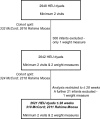Growth of HIV-Exposed Uninfected Infants in the First 6 Months of Life in South Africa: The IeDEA-SA Collaboration
- PMID: 27049853
- PMCID: PMC4822941
- DOI: 10.1371/journal.pone.0151762
Growth of HIV-Exposed Uninfected Infants in the First 6 Months of Life in South Africa: The IeDEA-SA Collaboration
Abstract
Background: HIV-exposed uninfected (HEU) infants are a growing population in sub-Saharan Africa especially with the increasing coverage of more effective prevention of mother-to-child transmission (PMTCT) antiretroviral therapy regimens. This study describes the characteristics of South African HEU infants, investigates factors impacting birth weight and assesses their growth within the first 28 weeks of life.
Methods: This is a retrospective cohort based on routine clinical data from two South African PMTCT programmes. Data were collected between 2007 and 2013. Linear regression assessed factors affecting birth weight-for-age z-scores (WAZ) while growth (longitudinal WAZ) was assessed using mixed effects models.
Results: We assessed the growth of 2621 HEU infants (median birth WAZ was -0.65 (IQR -1.46; 0.0) and 51% were male). The feeding modalities practised were as follows: 0.5% exclusive breastfeeding, 7.9% breastfeeding with unknown exclusivity, 0.08% mixed breastfeeding and 89.2% formula feeding. Mothers with CD4 <200 cells/μl delivered infants with a lower birth WAZ (adjusted ß -0.253 [95% CI -0.043; -0.072], p = 0.006) compared to mothers with aCD4 ≥500 cells/μl. Similarly, mothers who did not receive antiretroviral drugs delivered infants with a lower birth WAZ (adjusted ß -0.39 [95% CI -0.67; -0.11], p = 0.007) compared to mothers who received antenatal antiretrovirals. Infants with a birth weight <2 500g (ß 0.070 [95% CI 0.061; 0.078], p <0.0001) experienced faster growth within the first 28 weeks of life compared to infants with a birth weight ≥2 500g. Infants with any breastfeeding exposure experienced slower longitudinal growth compared to formula fed infants (adjusted ß -0.012 [95% CI 0.021; -0.003], p = 0.011).
Conclusion: Less severe maternal disease and the use of antiretrovirals positively impacts birth weight in this cohort of South African HEU infants. Formula feeding was common with breastfed infants experiencing marginally slower longitudinal growth.
Conflict of interest statement
References
-
- Goga A, Dinh T, Jackson D for the SAPMTCTE Study Group. Evaluation of the effectiveness of the national prevention of mother-to-child transmission (PMTCT) programme measured at six weeks postpartum in South Africa, 2010 [Internet]. South African Medical Research Council, National Department of Health of South Africa and PEPFAR/US Centers for Disease Control and Prevention; 2012. Available: http://www.doh.gov.za/docs/reports/2012/pmtcteffectiveness.pdf. Accessed 20 June 2013
-
- The 2012 National Antenatal Sentinel HIV & Herpes Simplex Type-2 Prevalence Survey, South Africa. National Department of Health Pretoria; 2013.
Publication types
MeSH terms
Substances
Grants and funding
LinkOut - more resources
Full Text Sources
Other Literature Sources
Medical
Research Materials


